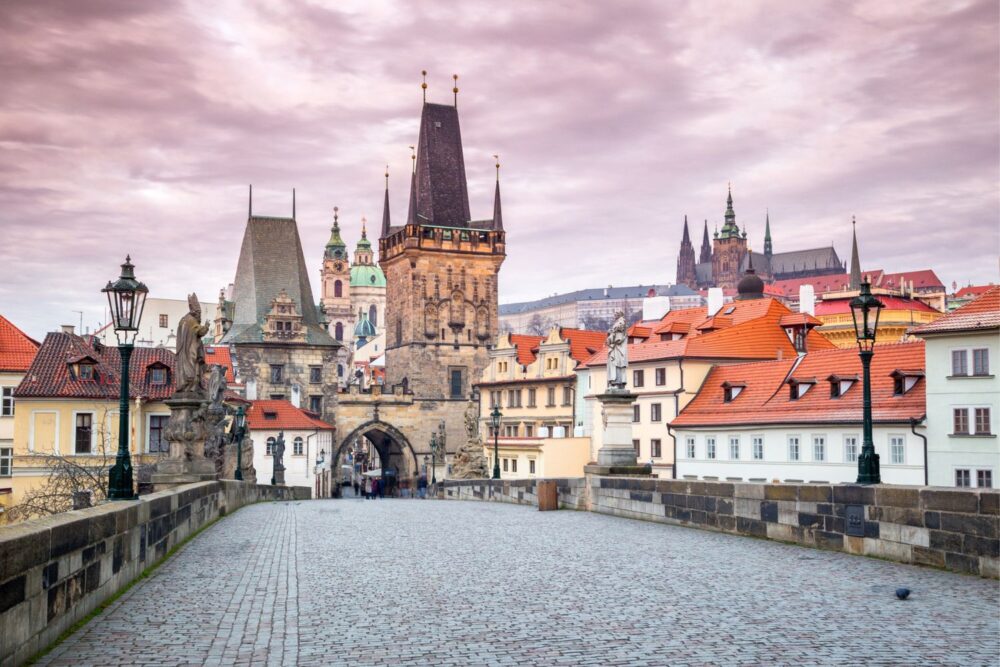Prague, the capital of the Czech Republic, is one of Europe’s hidden jewels, waiting to be discovered and enjoyed. Much of the city remains the same as in medieval times, making it a charming historical destination. If you enjoy labyrinthine cobblestone streets, ancient castles and cathedrals, and all the romance and intrigue of the age of chivalry, you will love what Prague has to offer!
Prague is known as the Golden City or the City of 1000 Spires because of its enormous number of historical buildings. It is a city to explore slowly on foot. Consider visiting in the spring or fall and not in the summer when the crowds descend upon Prague’s attractions, and prices go up.
Prague Castle
The centerpiece of Prague’s historic appeal is certainly Prague Castle, one of the largest medieval castles in the world, which dates back to 1100 AD. The castle and grounds stand upon 18 acres of land overlooking the city. The building remains the seat of the Czech government, an honor it has held since the 9th century.
Prague Castle boasts many architectural and artistic exhibits, some of which are only open to the public during certain months of the year. One particularly curious attraction within the castle is the Toy Museum, displaying toys from around the world and throughout history. Before you embark upon your journey, be sure to research which attractions will be open during your stay.
Of special note on the castle grounds is the gorgeous gothic cathedral of St. Vitius, which dates to 1344 AD. The most famous aspect of the cathedral is the chapel of St. Wenceslas, renowned for its lavish decor. If you enjoy such old architecture, you will also want to visit the Old Royal Palace, established in 1135 AD, which houses the coronation hall still employed today for the swearing-in of new Czech leaders.
A more modern attraction within Prague Castle is the network of tunnels dug during the Communist occupation circa 1950. These dark passages afforded easy and quick access to bomb shelters during those tumultuous and uncertain times.
Strahov Monastery
Other areas of Prague were deeply affected by Communist rule. The famous monastery in Hradcany (a residential area beyond the western city gate) functioned from its founding in 1140 AD until the Communist government closed the monastery and imprisoned most monks.
The monastery boasts a baroque church where Mozart is believed to have played. Also within the monastery is the Strahov Library, a monumental edifice containing a breathtaking collection of educational books and a thrilling display of frescos.
Petrin Hill
Petrin Hill – an impressive 1043-foot mound – offers eight parks full of greenery and natural life for those seeking more exposure to nature. The hill once contained a quarry from which most of the stone in Prague’s most notable buildings was mined, and remnants of the quarry can be still be seen today.
Prague’s very own “Eiffel Tower,” a copy constructed for the Prague Exposition in 1891, rests high atop Petrin Hill. The tower, known as Petrin Tower, rises 203 feet above the parks below. For a great view of the city and outlying land, you can climb to the top (for a small fee).
Old Town Hall
Near the city’s ancient center, with its famous monuments, bustling cafes, and cobbled streets, is the Old Town Hall. The town hall encompasses a row of buildings that include the boyhood home of prolific author Franz Kafka. The world-famous Astronomical Clock, constructed in 1410 AD, can still be observed in the town hall. Every hour visitors can watch the chilling mechanical show wherein Death rings a bell and tips his hourglass.
St. James Church
Another macabre attraction also resides off the Old Town Square. St. James Church is an intriguing gothic church containing a richly-decorated tomb and the shriveled arm of a thief who once attempted to steal some of the valuable decors.
Josefov
No visit to Prague would be complete without a stroll through Josefov, the Old Jewish Quarter. Considered a ghetto for most of its history, the quarter was meticulously preserved by Nazi leaders as historical documentation of the people they tried so fervently to eradicate.
In Josefov, you can see the Old-New Synagogue, Europe’s oldest functioning synagogue, established in 1210 AD. Be aware that all visitors must abide by the synagogue dress code restrictions: men must wear hats, and women may not proceed further into the building than an ante-chamber designated for observation.
The Old Jewish Cemetery is the oldest surviving Jewish burial ground, which first saw use in the 15th century. At least 100,000 graves rest within the cemetery, with thousands more graves relocated from other burial grounds. It stands as a monument to a people who remained strong in tremendous persecution.
Astronomical Clock
The Prague Orloj or Astronomical Clock sits in the heart of the city’s Stare Mesto old town. Dating back to the 15th Century, the mechanical astronomy clock chimes on the hour and is famous for its animated figures.
National Museum The Czech Republic’s national museum boasts a huge natural history collection and historical exhibits. The building itself is a marvel of neo-renaissance architecture. The Golden Lane, Prague’s smallest street behind the cathedral, was once home to Franz Kafka. Legend has it that alchemists used to conduct their esoteric experiments along the Golden Lane.
Vyshehrad
The Vyshehrad fortress marks Prague’s place and is surrounded by a beautiful park. The twin spires of the neo-Gothic Church of St Peter and St Paul dominate, and the views of Prague are breathtaking.
There’s more to experience in Prague
Seasonal and holiday displays and attractions are plentiful in Prague, so be sure to check a calendar of events. Czech and Prague-specific tourism boards provide many.
Each of the city’s unique quarters contains a plethora of historical, architectural, and artistic wonders. To make the most of your visit to Prague, consider investing in a guidebook or tourist map before your departure. Suppose you have limited time in the city. In that case, you will benefit from budgeting your time with a careful sight-seeing plan or joining one of the many professionally-guided tours offered around the city.

